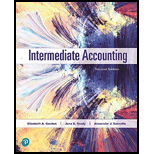
Intermediate Accounting (2nd Edition)
2nd Edition
ISBN: 9780134730370
Author: Elizabeth A. Gordon, Jana S. Raedy, Alexander J. Sannella
Publisher: PEARSON
expand_more
expand_more
format_list_bulleted
Question
Chapter 14, Problem 14.15Q
To determine
To explain: Whether a company elects the fair value option for long-term liabilities and if it can report the unrealized gains and losses in other comprehensive income.
Expert Solution & Answer
Want to see the full answer?
Check out a sample textbook solution
Students have asked these similar questions
Can you solve this financial accounting question with accurate accounting calculations?
I need assistance with this general accounting question using appropriate principles.
Please explain the correct approach for solving this general accounting question.
Chapter 14 Solutions
Intermediate Accounting (2nd Edition)
Ch. 14 - What conditions or terms does a note payable...Ch. 14 - If the market rate of interest exceeds the face or...Ch. 14 - What is included in bond issue costs and how...Ch. 14 - Prob. 14.4QCh. 14 - When a bond is issued at a discount, will its...Ch. 14 - Prob. 14.6QCh. 14 - Prob. 14.7QCh. 14 - Under IFRS, how do firms account for convertible...Ch. 14 - Prob. 14.9QCh. 14 - Can companies reclassify short-term debt expected...
Ch. 14 - Under IFRS, can companies reclassify short-term...Ch. 14 - Do companies always reclassify long-term debt that...Ch. 14 - Prob. 14.13QCh. 14 - Prob. 14.14QCh. 14 - Prob. 14.15QCh. 14 - Prob. 14.16QCh. 14 - Prob. 14.1MCCh. 14 - Prob. 14.2MCCh. 14 - Prob. 14.3MCCh. 14 - Prob. 14.4MCCh. 14 - Prob. 14.5MCCh. 14 - Clothes Horse Corp. (CHC) Issued 500,000 bonds due...Ch. 14 - Prob. 14.7MCCh. 14 - Prob. 14.8MCCh. 14 - Prob. 14.9MCCh. 14 - Prob. 14.10MCCh. 14 - Prob. 14.11MCCh. 14 - Prob. 14.1BECh. 14 - Notes Payable. Using the information provided in...Ch. 14 - Prob. 14.3BECh. 14 - Prob. 14.4BECh. 14 - Prob. 14.5BECh. 14 - Prob. 14.6BECh. 14 - Bond Terminology. Match each term with its...Ch. 14 - Bond Pricing. Fill in the missing items for each...Ch. 14 - Prob. 14.9BECh. 14 - Bond Issue Price. Using the information from...Ch. 14 - Prob. 14.11BECh. 14 - Prob. 14.12BECh. 14 - Prob. 14.13BECh. 14 - Prob. 14.14BECh. 14 - Prob. 14.15BECh. 14 - Prob. 14.16BECh. 14 - Prob. 14.17BECh. 14 - Prob. 14.18BECh. 14 - Bonds Issued between Interest Payment Dates. For...Ch. 14 - Prob. 14.20BECh. 14 - Prob. 14.21BECh. 14 - Prob. 14.22BECh. 14 - Prob. 14.23BECh. 14 - Prob. 14.24BECh. 14 - Prob. 14.25BECh. 14 - Prob. 14.26BECh. 14 - Prob. 14.27BECh. 14 - Prob. 14.28BECh. 14 - Prob. 14.29BECh. 14 - Prob. 14.30BECh. 14 - Short-Term Debt Expected to Be Refinanced, IFRS....Ch. 14 - Prob. 14.32BECh. 14 - Prob. 14.33BECh. 14 - Prob. 14.34BECh. 14 - Prob. 14.35BECh. 14 - Fair Value Option. Saratoga Company issued bonds...Ch. 14 - Prob. 14.37BECh. 14 - Financial Statement Disclosure. Use the following...Ch. 14 - Prob. 14.1ECh. 14 - Prob. 14.2ECh. 14 - Prob. 14.3ECh. 14 - Prob. 14.4ECh. 14 - Prob. 14.5ECh. 14 - Bond Issue, Interest Payments, Effective Interest...Ch. 14 - Prob. 14.7ECh. 14 - Prob. 14.8ECh. 14 - Prob. 14.9ECh. 14 - Prob. 14.10ECh. 14 - Prob. 14.11ECh. 14 - Prob. 14.12ECh. 14 - Convertible Bonds, Conversion. On January 1, 2018,...Ch. 14 - Convertible Bonds, Conversion. Using the...Ch. 14 - Prob. 14.15ECh. 14 - Prob. 14.16ECh. 14 - Prob. 14.17ECh. 14 - Prob. 14.18ECh. 14 - Warrants. DHC Associates issued 2,100 of its...Ch. 14 - Prob. 14.20ECh. 14 - Prob. 14.21ECh. 14 - Prob. 14.1PCh. 14 - Long-Term Notes Payable, Semiannual Interest,...Ch. 14 - Note Payable Issued at a Discount with...Ch. 14 - Prob. 14.4PCh. 14 - Prob. 14.5PCh. 14 - Bond Issue, Interest Payments, Effective Interest...Ch. 14 - Prob. 14.7PCh. 14 - Bonds Sold between Interest Dates at a Discount,...Ch. 14 - Prob. 14.9PCh. 14 - Prob. 14.10PCh. 14 - Convertible Bonds, Bond Issue Costs, Conversion....Ch. 14 - Prob. 14.12PCh. 14 - Prob. 14.13PCh. 14 - Prob. 1JCCh. 14 - Prob. 2JCCh. 14 - Prob. 3JCCh. 14 - Prob. 1FSCCh. 14 - Prob. 1SSCCh. 14 - Surfing the Standards Case 2: Bonds with...Ch. 14 - Prob. 1BCC
Knowledge Booster
Similar questions
- Can you explain this general accounting question using accurate calculation methods?arrow_forwardAnswerarrow_forwardReliable Production company has a beginning finished goods inventory of $24,500, raw material purchases of $31,200, cost of goods manufactured of $42,800, and an ending finished goods inventory of $27,300. The cost of goods sold for this company is?arrow_forward
- I need help finding the accurate solution to this general accounting problem with valid methods.arrow_forwardPlease provide the correct solution to this financial accounting question using valid principles.arrow_forwardI am looking for help with this general accounting question using proper accounting standards.arrow_forward
- Please provide the correct answer to this general accounting problem using accurate calculations.arrow_forwardPlease explain the solution to this financial accounting problem with accurate explanations.arrow_forwardPlease explain the correct approach for solving this general accounting question.arrow_forward
arrow_back_ios
SEE MORE QUESTIONS
arrow_forward_ios
Recommended textbooks for you
 Cornerstones of Financial AccountingAccountingISBN:9781337690881Author:Jay Rich, Jeff JonesPublisher:Cengage Learning
Cornerstones of Financial AccountingAccountingISBN:9781337690881Author:Jay Rich, Jeff JonesPublisher:Cengage Learning College Accounting, Chapters 1-27AccountingISBN:9781337794756Author:HEINTZ, James A.Publisher:Cengage Learning,
College Accounting, Chapters 1-27AccountingISBN:9781337794756Author:HEINTZ, James A.Publisher:Cengage Learning,

Cornerstones of Financial Accounting
Accounting
ISBN:9781337690881
Author:Jay Rich, Jeff Jones
Publisher:Cengage Learning

College Accounting, Chapters 1-27
Accounting
ISBN:9781337794756
Author:HEINTZ, James A.
Publisher:Cengage Learning,

